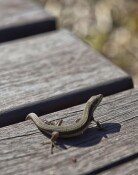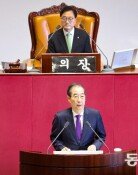Reagan`s statue in Budapest
A statue of the late U.S. President Ronald Reagan was erected Wednesday at Freedom Square in front of the U.S. Embassy in central Budapest, Hungary. In the unveiling ceremony, the Hungarian government said, We are grateful to former U.S. President Ronald Reagan for helping us recover our sovereignty by ending the Cold War, and we will remember him forever. Reagan never visited Hungary, but Hungarians and their government celebrated the centennial anniversary of his birth. Budapest put up a bust of Reagan three years ago and issued stamps to mark his centennial birthday in March.
The phrase the end of the Cold War Budapest mentioned was used by Reagan in a speech he gave in Berlin on June 12, 1987. In front of Brandenburg Gate overlooking the Berlin Wall, he made a bold suggestion to Soviet Union leader Mikhail Gorbachev by saying, General Secretary Gorbachev, if you seek peace, if you seek prosperity for the Soviet Union and Eastern Europe, if you seek liberalization, come here to this gate! Mr. Gorbachev, open this gate! Mr. Gorbachev, tear down this wall!
The Berlin Wall collapsed on Nov. 9, 1989, 29 months after Reagans famous speech and 10 months after he left office. His Berlin speech proved to be a prophetic message that heralded global upheaval. Over his eight years in the White House, Reagan called the Soviet Union the evil empire and pursued peace through power. Such a policy toward Moscow was the driving force that ended the Cold War. The magazine U.S. News and World Report in 2007 selected Reagans Berlin speech as one of the seven greatest speeches by a U.S. president.
Upon hearing the news of the unveiling of Reagans statue in Budapest, South Koreans might have been reminded of the statue of Gen. Douglas MacArthur at Freedom Park in Incheon. MacArthur prevented South Korea from being communized by North Korean founder Kim Il Sung in the Korean War. Had it not been for U.S. President Harry Truman, who sent American soldiers to fight in the war, MacArthur, who led the Incheon landing, and U.N. troops, who sacrificed themselves for an unknown country, South Koreans would live under the rule of Kim Jong Il. Due to radical groups who often stage protests and try to destroy the statue, fences were set up in front of it and police officers stand guard every day. Those who criticize MacArthur for preventing Korean reunification might hope for reunification through communization.
Editorial Writer Bhang Hyeong-nam (hnbhang@donga.com)






